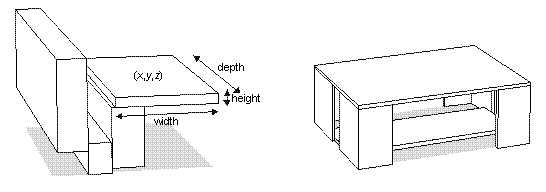

Phenotype:
|
x, y, z, width, height, depth of block 1 x, y, z, width, height, depth of block 3 x, y, z, width, height, depth of block 5 |
x, y, z, width, height, depth of block 2 x, y, z, width, height, depth of block 4 ....... x, y, z, width, height, depth of block 16 |
Genotype:
|
11010110 |
10101101 |
10101110 |
10011010 |
01101010 |
01101010 |
... |
10001010 |
10001010 |
10001010 |
|
desired xpos 1 |
desired ypos 1 |
desired zpos 1 |
desired width 1 |
desired height 1 |
desired height 1 |
... |
desired width 4 |
desired height 4 |
desired depth 4 |
Figure. Generative Evolutionary Design of a table.
The figure shows how a Generative Evolutionary Design System approaches the task of evolving a table. The initial population begins with randomly shaped 'blobs' (left), and evolution is used to gradually fine-tune these shapes until they function as tables (right). The representation is crucial for such systems - every part of the design must be alterable. In this example, designs (phenotypes) are represented by a number of blocks, defined by their 3D position and size. Genotypes define desired 3D position and size genes. As alleles are mapped to parameter values, the values may change slightly (i.e., two overlapping blocks are 'squashed' until they touch rather than overlap). Genotypes may define partial designs, which are subsequently reflected to form symmetrical phenotypes (right of figure). These simple mapping processes mean that there is no longer a direct one-to-one mapping between genes and parameters - the form of designs is affected by interactions between different genes.